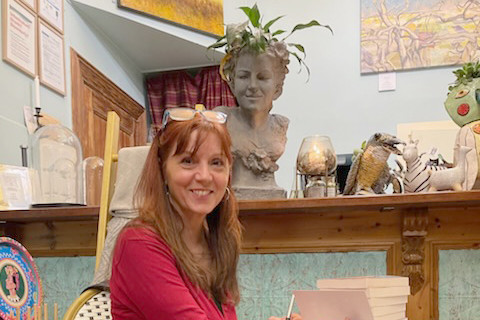General News
20 June, 2024
A story told in four voices
A reading of Lia Hills' new novel The Desert Knows Her Name took place last Friday at the Dimboola Imaginarium, with the author attending to promote her book and explain some of the deeper concepts she hopes she has been able to convey through the pages.

Ms Hill said there were many features within the story that would be familiar to locals, especially in Dimboola and Natimuk - even though it is set in a fictional town - because she spent so much time in the region researching the details.
"When I knew I would be releasing this book I said to my publishers 'Yes, we can do all the Melbourne stuff that is required, but I really need to come up to the Wimmera and do these events', because it is so important to this book," Ms Hills said.
“I read up on the local flora and fauna and spoke to Johnathan Stark.
“I consulted with Goolum Goolum and Barengi Gadjin Land Council a lot to make sure I was portraying the Traditional Owners and Elders respectfully, and they shared their knowledge of the Little Desert’s plants and animals with me too.”
Ms Hills said the majority of the book was initially drafted in a style which she was new to.
“I actually spoke it, recorded it on my phone software, before I wrote it,” she said.
“I had the opportunity to stay at an old farmhouse at Dattyk, alone, for two weeks, and I would go out each day and find just the right spot to sit quietly, let all the birds and insects become accustomed to my presence.
“Then, once I had absorbed it all, I would begin telling the story.”
Ms Hills said every morning a Rainbow Bee-Eater would appear in the yard - “like a rainbow exploding from the ground” - and when she saw the list of options for the novel’s cover, she chose the bird which had been her companion during the writing process.
“I was firm. They kept showing me other options and saying ‘What about this one, or that one’, but I said no to them all,” she said.
The book features four “voices”, Ms Hill said. Beth, Nate, and the anonymous, mute girl who appears out of the desert are the obvious ones, but less obvious is the narrator, the land itself, which Ms Hills said had its own voice and its own story to share.
“The girl says she is not a ‘messenger’, but she and the land both have something to share,” she said.
“There are some uncomfortable, confronting themes in the book that challenge the way we think about certain long-standing issues, especially in small rural towns, and I’m looking forward to hearing what people think of these parts.”
Dimboola Imaginarium owner Chan Uoy said hosting authors like Ms Hills was an important promotion for both the writer and the region.
“Writing a book is difficult," Mr Uoy said.
"We’re talking about years of an author’s life, so when these stories come out, especially when they are about our towns and our region, it is important to celebrate them.
“We support them and promote them because stories like these are another way we can connect with other people beyond the Wimmera and grow their interest in us.”
The Desert Knows Her Name is available online, at the Dimboola Imaginarium, and at Redrock Books and Gallery in Horsham.
Read More: Dimboola